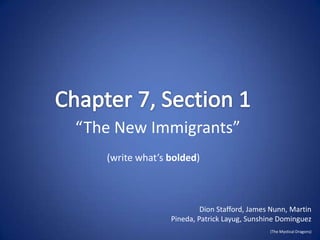
History pp ch 7 sec 1
- 1. “The New Immigrants” (write what’s bolded) Dion Stafford, James Nunn, Martin Pineda, Patrick Layug, Sunshine Dominguez (The Mystical Dragons)
- 2. Immigration to America -Millions of immigrants entered the US in the late 19th and early 20th centuries -Moved to escape difficult living conditions such as famine, land shortages, or religious or political persecution. -Things such as birds of passage intended to immigrate temporarily to earn money and then return to homeland.
- 3. Europeans -Between 1870 and 1920 20 million Europeans arrive in US -1890, most immigrants came from western and northern Europe beginning of 1890 immigrants came from southern and eastern Europe. -Many immigrants left to escape religious persecution. (for example: the jews were driven out of Russia)
- 4. -Others left because of rising population (scarcity of land, farmers vs. laborers). -Jobs were plentiful in US -They were influenced by political movements at home, young men and women moved to US.
- 5. Chinese -1851-1883 300,000 Chinese immigrants arrived -Many came to seek their fortunes after the discovery of gold in 1848 (California Gold rush) -Chinese helped build nation’s railroads including the first transcontinental line. -Farming, mining, and domestic services
- 6. -1884, Japanese government allowed Hawaiian planters to recruit Japanese workers and a Japanese emigration boom began. -Annexation of Hawaii in 1898 resulted in increased Japanese migration of west coast. -Immigration continued to increase as word of higher wages spread. -By 1920 more than 200,000 Japanese lived on west coast
- 7. The West Indies and Mexico -1880-1920: about 260,000 immigrants from the West Indies came to Eastern and South Eastern U.S in search of work during the Industrial boom -Many came from Puerto Rico, Cuba, Jamaica, and other Islands -Mexicans also come to the U.S in search of jobs and also to flee political turmoil.
- 8. -1902: National Reclamation Act (encouraged irrigation of arid land) created new farmland in the Western States which attracted Mexican workers. -1910: political and social upheavals in Mexico prompt more immigration -Over the next 20 years, about 700,000 people came to the U.S
- 9. A Difficult Journey -1870: almost all immigrants traveled by steamship. The trip from Europe across the Atlantic took one week. Asia to the Pacific took about 3 weeks. -Immigrants traveled in steerage- cheap accommodations in ships’ cargo holds. They were rarely allowed on deck and slept in mouse infested bunks. -Shared toilets with many other passengers. -Because of these conditions, disease spread quickly and killed some people before they reached their destination.
- 10. Ellis Island • Chief immigration station in the US from 1892 – 1924. • Estimated 17 million European immigrants passed through it. • About 20% of the immigrants were detained for a day or more before being inspected. Only 2% of those were denied entry. • The processing takes 5 hours or more: – had to pass a physical examination, anyone with serious health problem or contagious disease was sent home – Inspector checked if they meet the legal requirements such as: Had never been convicted of a felony Demonstrating they’re able to work Had some money at least $25 • Interpreters were use to overcome the language problem
- 13. Angel Island • Asians (primarily Chinese) immigrants arriving on the West Coast gained admission at Angel Island in San Francisco Bay. • Between 1910-1940, about 50,000 Chinese immigrants entered the U.S. • Immigrants in Angel island endured harsh questioning and long detention compared to the immigrants in Ellis Island.
- 15. Cooperation For Survival Challenges after admission into the country: -finding a place to live -getting a job -getting along in daily life and understanding unfamiliar language & culture. -Ethnic communities stuck together, pooled their $$ to build churches/synagogues, social clubs and aid societies. -Native born Americans often disliked the immigrants’ unfamiliar customs and languages and viewed them as a threat to the American way of life.
- 16. The Rise of Natavism -Melting Pot- A mixture of different cultures and races who blended together by abandoning their native languages and customs -Immigrants didn’t want to give up cultural identities -As immigration increased, strong anti immigrant feelings increased -Natavism- overt favoritism toward native born Americans -Believed English were superior to other ethnic groups.
- 17. Immigration Restriction League -founded by Prescott F. Hall - “Right” countries- British, German, and Scandinavians - “Wrong” countries- Slav, Latin, and Asiatic races American Protective Association -Natavist group formed in 1887 -Anti-Catholic -Many colleges, businesses and social clubs refused to admit Jews.
- 18. 1897- IRL passed a bill requiring a literacy test for immigration. -had to read 40 words in English or their native language for entry. President Cleveland vetoed the bill. -A similar bill would be passed in 1917 despite the veto.
- 19. Anti-Asian Sentiment -Native born workers feared that jobs would go to Chinese immigrants who would accept lower wages. -The founder of the working party, Denis Kearny headed the anti-Chinese movement in California. -In 1992 Congress slammed the door on Chinese immigration for ten years by passing the Chinese exclusion act. -Banned entry to all Chinese except students, teachers, merchants, tourists and government officials.
- 20. The Gentlemen’s Agreement When Japan raised an angry protest at this - treatment of emigrants, President Theadore Roosevelt worked out a deal. - Gentlemen’s Agreement: 1907-1908 Japan’s government agreed to limit emigration of unskilled workers to the US for the repeal of the SF segregation order.